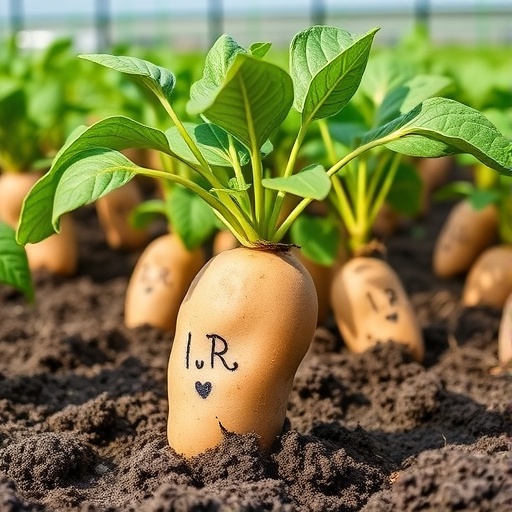In a groundbreaking study published in BMC Genomics, researchers have embarked on an extraordinary exploration of the autotetraploid potato, specifically focusing on its high-resolution diel transcriptomes. This intriguing aspect of the potato’s biology involves understanding how gene expression fluctuates over a 24-hour period, or diel cycle, revealing valuable insights into the plant’s adaptive mechanisms. This study, authored by Feke, Vaillancourt, Acheson, and others, represents a significant stride in plant genomics, promising to unlock the mysteries behind rhythmic gene expression in this vital crop.
At the heart of this research lies the autotetraploid potato, a variant of the common potato that has undergone whole-genome duplication, resulting in four sets of chromosomes. This unique genetic makeup is particularly noteworthy because it provides an opportunity to investigate gene expression dynamics with unparalleled detail. The autotetraploid condition causes alterations in gene regulation, which can lead to variations in phenotypic traits such as growth, yield, and stress response. Hence, understanding the transcriptomic landscapes of these potatoes is crucial not only for basic science but also for practical agricultural applications.
The authors employed cutting-edge high-throughput sequencing technologies to generate high-resolution transcriptome data, capturing the transient expression patterns of thousands of genes across different time points throughout the diel cycle. With these extensive datasets, researchers can now identify rhythmic genes that are expressed in a periodic manner, which may be critical for the plant’s adaptation to external environmental cues such as light and temperature. This rhythmicity in gene expression is fundamentally tied to the plant’s circadian rhythms, influencing processes like photosynthesis, hormone signaling, and stress responses.
One of the notable findings of the study is the degree of conservation observed among rhythmic genes. Despite the complexity introduced by autotetraploidy, certain genes displayed a remarkable consistency in their expression patterns across generations. This conservation suggests that the underlying genetic mechanisms controlling these rhythmic expressions are robust, potentially indicating evolutionary advantages conferred by such traits. The researchers posit that understanding these conserved rhythmic genes could aid in developing cultivars with enhanced resilience and productivity.
The research also delves into the implications of these findings for agricultural biotechnology. With climate change and other environmental challenges posing significant threats to global food security, the ability to harness the natural adaptability of crops such as the autotetraploid potato becomes paramount. By identifying key genes and their expression patterns, it may be possible to engineer varieties that are better equipped to thrive in stress conditions, thereby augmenting food production systems.
Furthermore, the study highlights the importance of integrating genomics with agronomic practices. The insights gleaned from the diel transcriptomic analysis provide a foundational understanding that can inform breeding strategies aimed at optimizing potato cultivation under varying environmental conditions. By targeting specific genes associated with desirable traits, scientists and farmers can collaborate to produce potato varieties that not only meet market demands but also cater to the needs of changing ecosystems.
In conclusion, the research led by Feke and colleagues is a significant contribution to the field of plant genomics and agricultural science. It offers a comprehensive view of the complex interplay between genotype and phenotype in autotetraploid potatoes and underscores the importance of rhythm in gene expression. With the advent of advanced genomic technologies, the potential for further discoveries in this area is immense, paving the way for innovations that could redefine agricultural practices and enhance food security globally.
As the study continues to receive attention within the scientific community and beyond, it serves as a reminder of the incredible potential that lies within our crops, waiting to be unraveled through research and innovation. By understanding the intricacies of autotetraploid potatoes, researchers not only contribute to our scientific knowledge but also take a significant step toward ensuring a sustainable future for agriculture.
The implications of these findings could reach far beyond the potato itself. The methodologies employed in this research are applicable to various species, particularly those that have undergone genome duplications. As such, the insights gained may inform broader questions in plant biology, evolutionary studies, and even responses to climate change across diverse plant species.
In a world increasingly affected by environmental challenges, the symbiosis of advanced research methodologies and agricultural practices becomes essential. The ongoing exploration of autotetraploid potatoes represents a microscopic yet vital example of how understanding plant biology can contribute significantly to global challenges, promoting both scientific inquiry and practical solutions to ensure food security.
As we move forward, continuous advancements in genomic technologies and analytical techniques will only serve to deepen our understanding of plant systems at an unprecedented scale, unlocking opportunities for improved crop resilience and adaptability. Ultimately, studies like this reflect the larger narrative of science working in harmony with nature to foster sustainable agricultural practices that can endure through the test of time.
Incorporating these various perspectives, the contributions of Feke, Vaillancourt, Acheson, and their team herald a new chapter in agricultural research, bridging the gap between fundamental science and practical application. Their findings not only advance our understanding of autotetraploid potatoes but act as a beacon for future research that aims to revolutionize how we approach crop improvement and resilience in an era of change.
The scientific community eagerly anticipates the further implications and applications arising from this research, hoping it will inspire similar studies across varied crops and ecosystems. As the field of genomics continues to evolve, the lessons learned from the autotetraploid potato will undoubtedly resonate widely, empowering scientists and farmers alike in the quest for sustainable agricultural solutions.
Subject of Research: Autotetraploid potato and its diel transcriptomes
Article Title: High resolution diel transcriptomes of autotetraploid potato reveal expression and sequence conservation among rhythmic genes
Article References: Feke, A., Vaillancourt, B., Acheson, K. et al. High resolution diel transcriptomes of autotetraploid potato reveal expression and sequence conservation among rhythmic genes. BMC Genomics 26, 925 (2025). https://doi.org/10.1186/s12864-025-11945-8
Image Credits: AI Generated
DOI:
Keywords: autotetraploid potato, diel transcriptomes, rhythmic genes, gene expression, plant genomics, genome duplication, agricultural biotechnology, food security, crop resilience.




